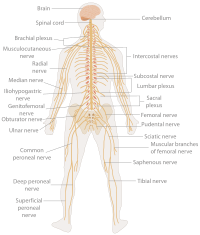
Photo from wikipedia
ABSTRACT Stroke can lead to motor impairments that can affect the body structure and restraint mobility. We hypothesize that brain lesions and their motor sequelae can distort the body schema,… Click to show full abstract
ABSTRACT Stroke can lead to motor impairments that can affect the body structure and restraint mobility. We hypothesize that brain lesions and their motor sequelae can distort the body schema, a sensorimotor map of body parts and elements in the peripersonal space through which human beings embody the reachable space and ready the body for forthcoming movements. Two main constructs have been identified in the embodiment mechanism: body‐ownership, the sense that the body that one inhabits is his/her own, and agency, the sense that one can move and control his/her body. To test this, the present study simultaneously investigated different embodiment subcomponents (body‐ownership, localization, and agency) and different neurophysiological measures (galvanic skin response, skin temperature, and surface electromyographic activity), and the interaction between them, in clinically‐controlled hemiparetic individuals with stroke and in healthy subjects after the rubber hand illusion. Individuals with stroke reported significantly stronger body‐ownership and agency and reduced increase of galvanic skin response, skin temperature, and muscular activity in the stimulated hand. We suggest that differences in embodiment could have been motivated by increased plasticity of the body schema and pathological predominance of the visual input over proprioception. We also suggest that differences in neurophysiological responses could have been promoted by a suppression of the reflex activity of the sympathetic nervous system and by the involvement of the premotor cortex in the reconfiguration of the body schema. These results could evidence a body schema plasticity promoted by the brain lesion and a main role of the premotor cortex in this mechanism. HIGHLIGHTSStroke could increase body‐ownership and agency over an external limb.Stroke could limit changes in galvanic skin response and skin temperature.Illusion of ownership could decrease electromyographic activity in stroke subjects.It is hypothesized that the premotor cortex could cause these effects.Results could evidence a body schema plasticity promoted by stroke.
Journal Title: Neuropsychologia
Year Published: 2017
Link to full text (if available)
Share on Social Media: Sign Up to like & get
recommendations!